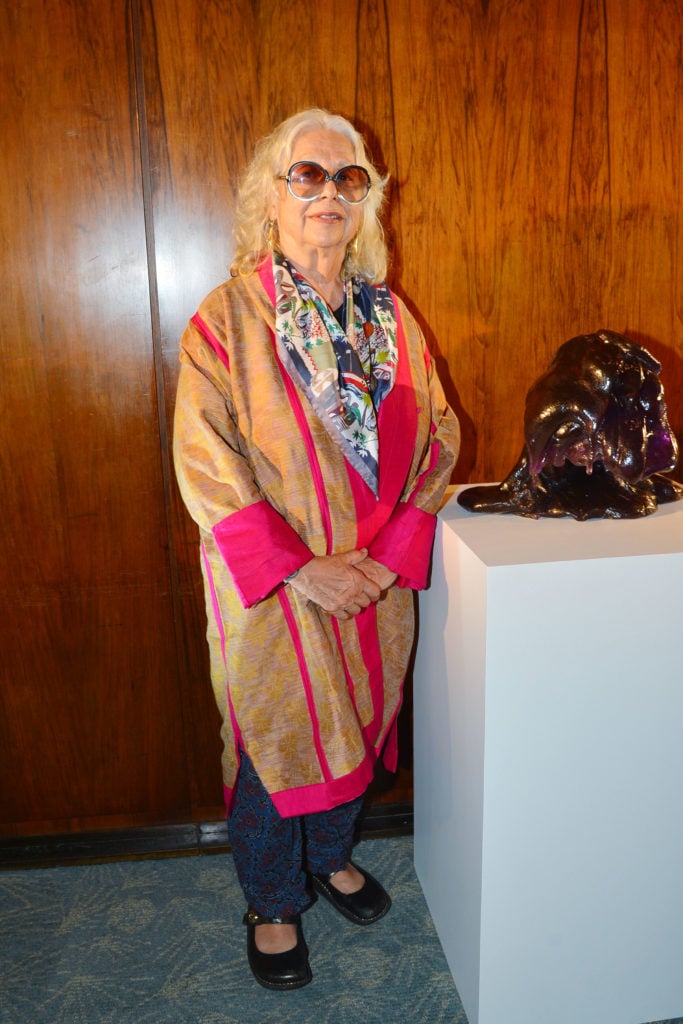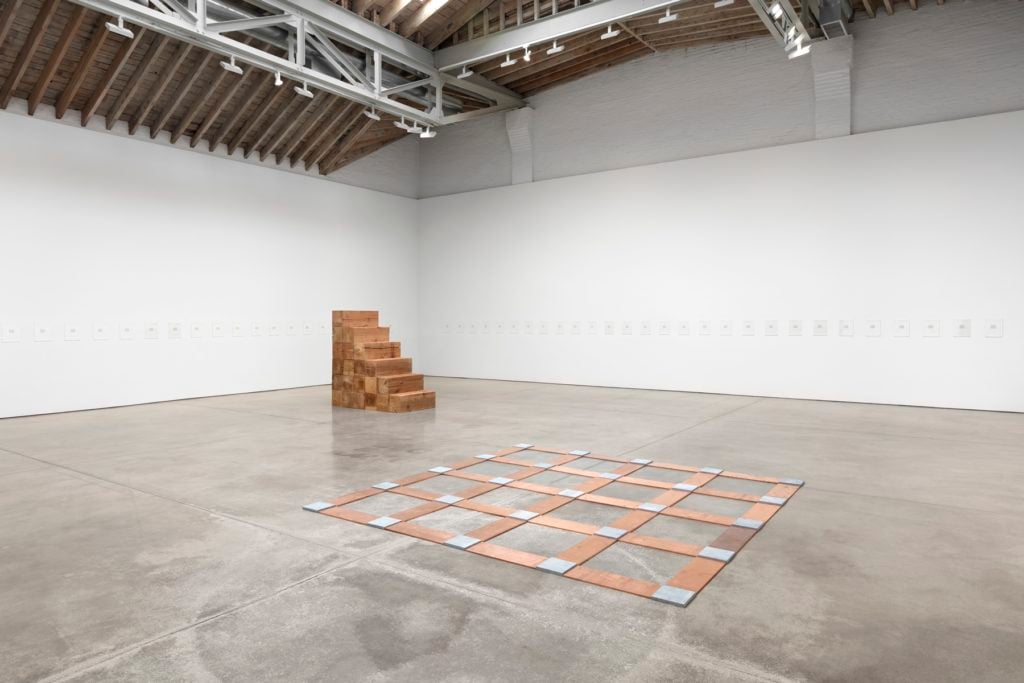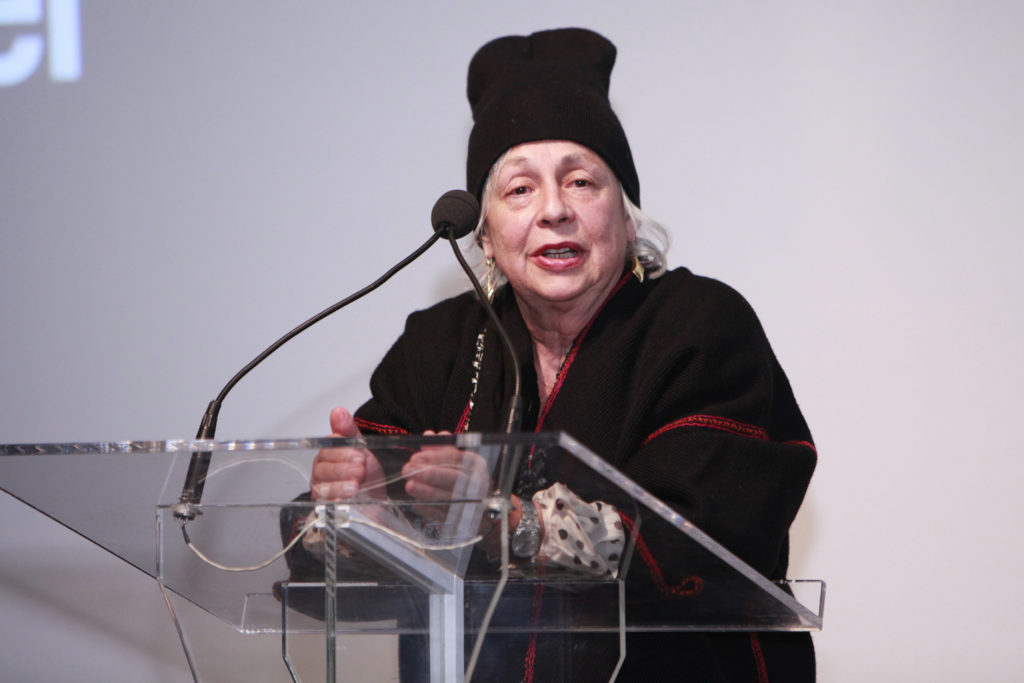Art World
Lynda Benglis on the Pleasures of Decoration, and Why She’s ‘Very Uncomfortable’ Being Called a Feminist Artist
On the occasion of her new show at Paula Cooper gallery, we spoke to the artist about how she views her place in art history.

On the occasion of her new show at Paula Cooper gallery, we spoke to the artist about how she views her place in art history.

Margaret Carrigan

Few figures have cast as long a shadow over the history of feminist art than Lynda Benglis; fewer still have done it with a penis. The artist’s legendary 1974 Artforum ad, in which she posed buck-naked with a giant double-ended dildo between her legs, sparked outrage—and more than one editorial resignation from the magazine’s masthead—while also helping Benglis become one the most renowned female artists of the last half-century. But it was her enthusiastic incorporation of glitz and garishness into the visually subdued, male-dominated world of Minimalism that confirmed Benglis as an artist to be reckoned with.
Now, at New York’s Paula Cooper gallery, the artist is part of another double-header, where two concurrent solo shows pay tribute to both her and her macho Minimalist peer, Carl Andre. Yet the 76-year-old artist sees herself and her work in far more expansive terms than society’s gender-binary system allows. Margaret Carrigan spoke with Benglis about basic biology, having a sense of humor, and her discomfort with being branded a feminist icon.

Installation view of “Carl Andre and Lynda Benglis” at Paula Cooper Gallery, NY May 10–June 16, 2018. Photo: Steven Probert. Courtesy Cheim & Read, New York.
Irreverence is part of your “brand,” for lack of a better term, not just because of your infamous 1974 Artforum ad but also because of the sardonic wit you employ in some of your videos, and the ostentatiously florid materials—like brightly colored latex and glitter—that you use in your object-based work, like. All of this flew in the face of the Minimalist conventions when you started making it in the 1960s. This element of fun, or at least humor, is consistent throughout your career, and you once even said that art is “play.” Is playfulness a key driver for you in your work?
I think everyone has a sense of play, because it allows for experimentation. It’s innate in us from childhood, but it’s more than that, too. It’s just an animal thing, you know? It’s not really known whether other animals make art—scientists speculate some birds make aesthetically pleasing nests to attract mates. But all animals play. So there’s some sort of biological imperative there to have fun.
It’s not just fun and games, though, right? Through play, animals also learn important lessons about survival but within a safe space. Does that factor into playfulness in art at all in your opinion?
Definitely. The need to make art is equal to eating and sleeping, at least for artists, and I think that relates to instinct. I’d like to throw out an idea now that you mention this. Think back to cave art—it always had to do with catching and eating food, and the rituals around that. So art was about survival, from the very beginning. I would even say it was specifically about creating social wellbeing and homemaking.
Homemaking is a culturally loaded term, as it has definite gender-specific connotations that relate to women and their role in society. Are you linking homemaking with creative expression at large?
I’m interested in this idea of decoration. Years ago, at the height of Minimalism, a well-known critic said to me, “Lynda, your art is so decorative.” And I said, “What’s wrong with decoration?” That was around the time Barbara Rose coined the term “ABC Art” to describe art being stripped to its bare bones, and that idea just didn’t go with decoration. But I was looking at stuff like Frank Stella’s work and I didn’t see a huge difference between the two. He was interested in things like graphics and symbols and how those are reductive, but those things can be repeated visually, flattening their meaning out and turning them into something like decoration.
Well, you essentially made the definitive link between decoration and Minimalism. Your latex floor pours and amorphous sculptures all operate in the same vein as other Minimalist works like Donald Judd’s cubes and Carl Andre’s grids in that they are experiential rather than narrative. Unlike their work, however, which is very muted in appearance, yours is shiny, sparkly, and sometimes even glow-in-the-dark. I dare say, you bedazzled Minimalism. What interested you about those materials?
Like I said earlier, it’s an animal thing. We’re inherently attracted to shiny, sparkly things. Our eyes are honed by millennia of evolution to see them. But as we become increasingly socialized, we’re taught to limit our appreciation for glitter. I grew up with sparkly things, like my dance baton and my bright pink girl’s dance costume, and I loved those things. I still do. Why should what we’re naturally drawn to be conditioned out of us?

Installation view of “Carl Andre and Lynda Benglis” at Paula Cooper Gallery, NY May 10–June 16, 2018. Photo: Steven Probert. Courtesy Cheim & Read, New York
What’s curious is that so many of these qualities that you say are objectively attractive to humans—bright colors, sparkle, shine—have gender associated with them in some way. In other words, they’re largely, well, girly. Your introduction of this kind of feminine aesthetic into the male-dominated field of Minimalism was—and is—hailed as a rebuke of the boys-club mentality. Was that an intentional subversion that you built into your work?
No, not at all. Look, men and women are taught to be disciplined within their social contexts, that’s a fact. But I just really like this kind of stuff, and artists can make up their own rules anyhow. That’s all I was doing. Carl Andre was actually the first artist I invited into my studio, back when I first was making work in New York. He didn’t judge my sex, he just said when he saw my work, “Oh, you’re a real artist.” That’s when I was making my wax paintings and making my own shapes. He was responding to what I was doing, not who I was.
But who you are has become significant to an entire generation or two of subsequent artists, many of who—like Cindy Sherman, who has cited your work as incredibly influential on her own—have gone on to become heroes of feminism in the art world themselves. How comfortable are you going down as an icon in the annals of feminist art history?
Very uncomfortable! I always felt like I was some kind of prisoner walking the line there. Then, as now, I would consider myself a humorist and, above all, a humanist. But, you know, I rode the feminist wave back then anyway, so I suppose it makes sense.

Lynda Benglis at the Sculpture Center Gala in 2010. Photo: Shaun Mader/PatrickMcMullan.com, ©PatrickMcMullan.
Ok, I have a bit of a leading question then.
Great, go ahead and put the halter on.
With the recent Women’s March and #metoo movements, there’s a corresponding surge of attention being paid to female artists, both past and present, in an effort to right the historical balance and support the careers of women who have suffered exploitation or obscurity in our male-centric culture. In this current wave of feminism, when your work is once again being contextualized as a milestone, are you still uncomfortable with being seen as a feminist artist?
Discomfort drives artists to make work, you know. I think I put a little humor in the last women’s movement, but my work isn’t about that.
So, while you continue to inspire another generation of artists, what continues to inspire you? I remember in an interview you did with John Baldessari a few years ago, you noted that you don’t derive a lot of inspiration from other artists’ work. What gets you going creatively?
I dream in a kind of abstract ways about juxtaposing space and ideas. I just wait until I’m excited about something. I remember being in the Louvre a long time ago and I was excited about the leap from Ionian to Corinthian columns in Classical architecture, and how they became more decorative. Little things like that are actually huge culturally. Likewise, I got excited about the Grand Canyon once. It was something so natural, an organically formed phenomenological experience like no other. That’s what makes me feel inspired.